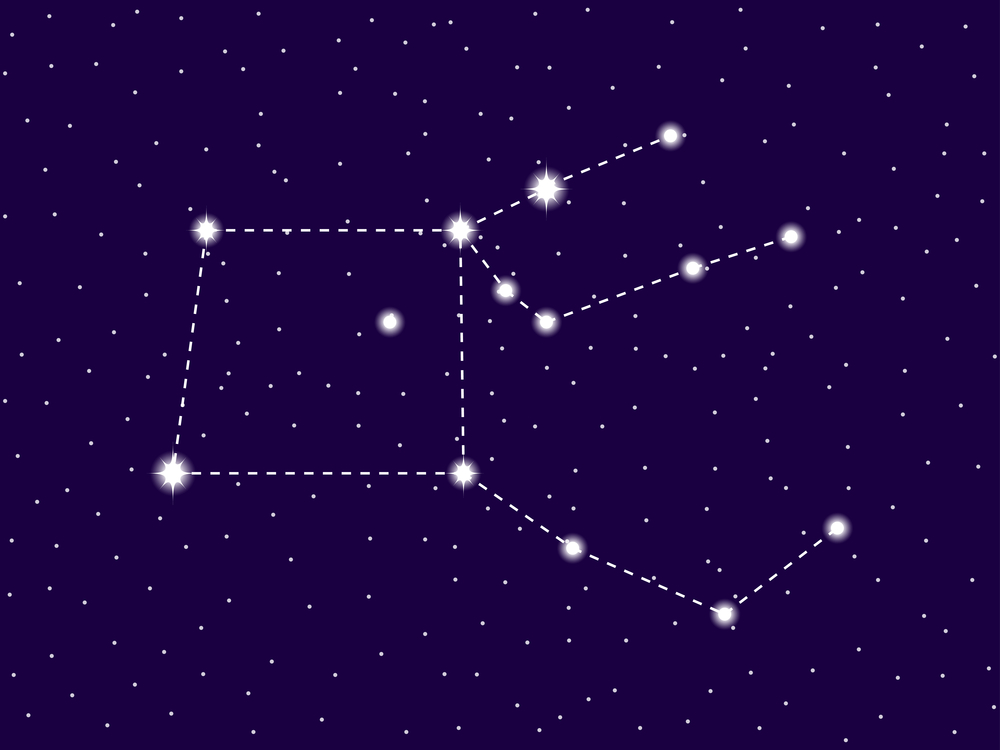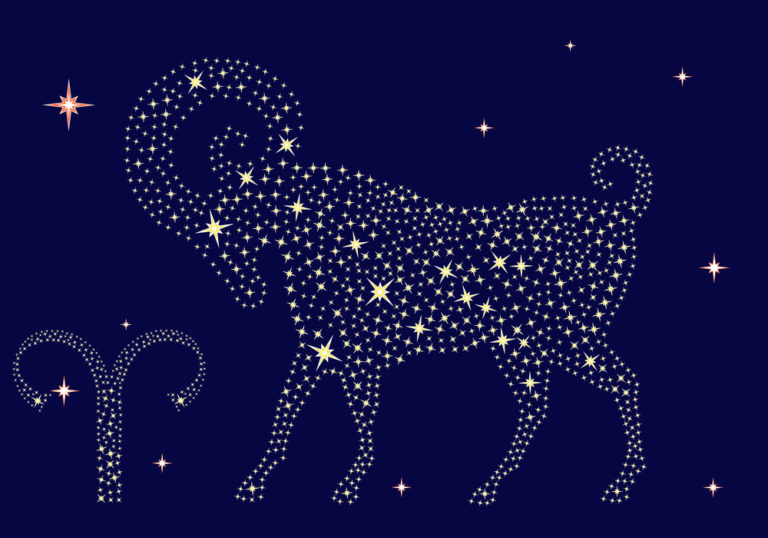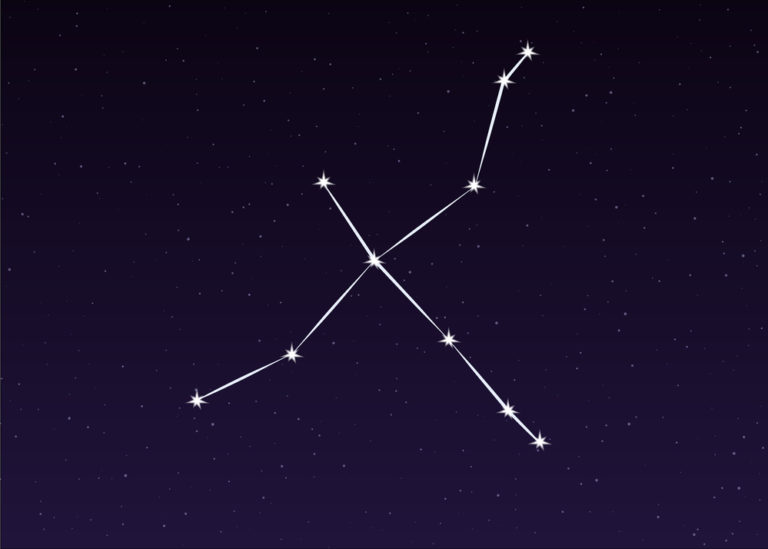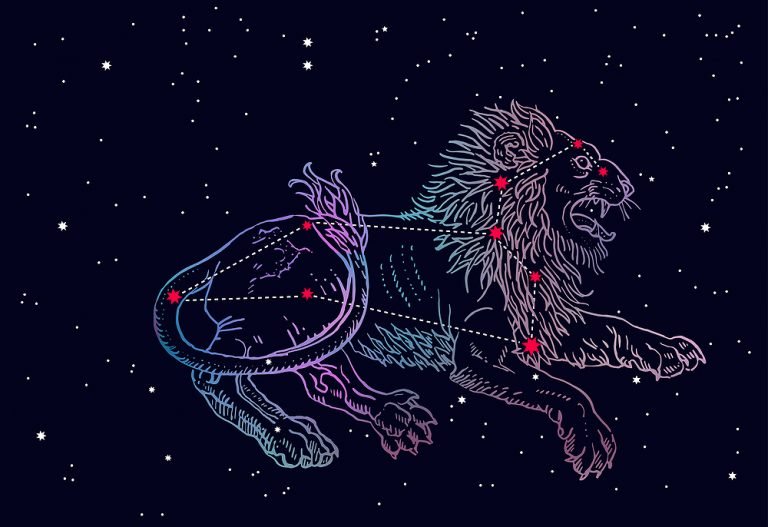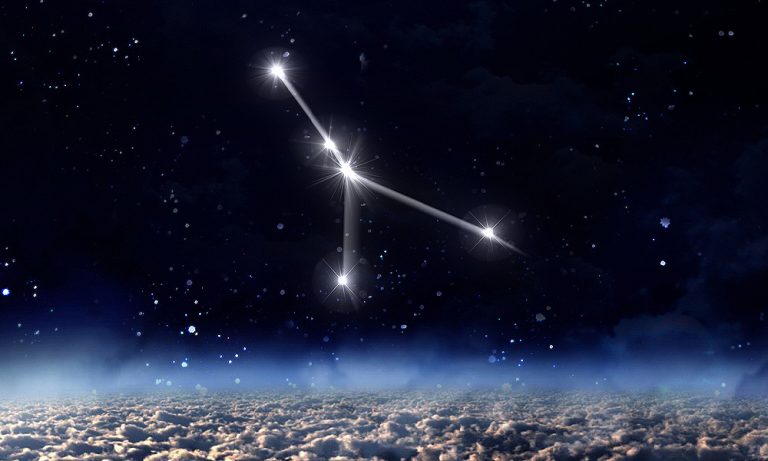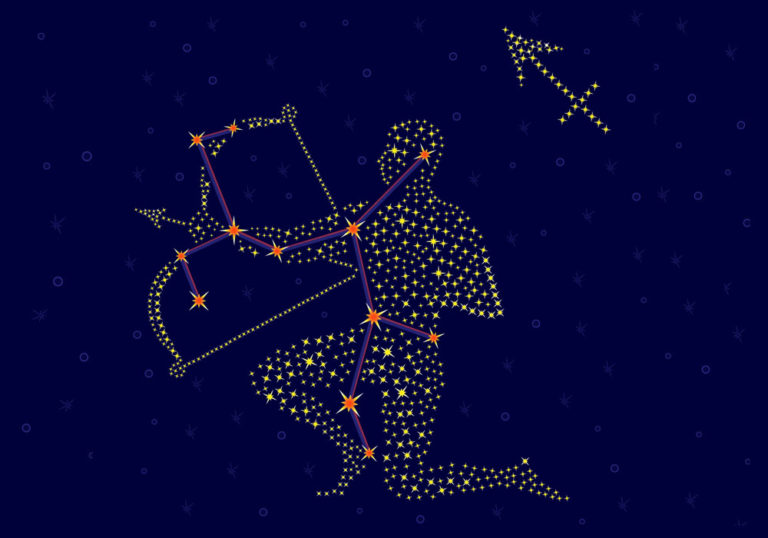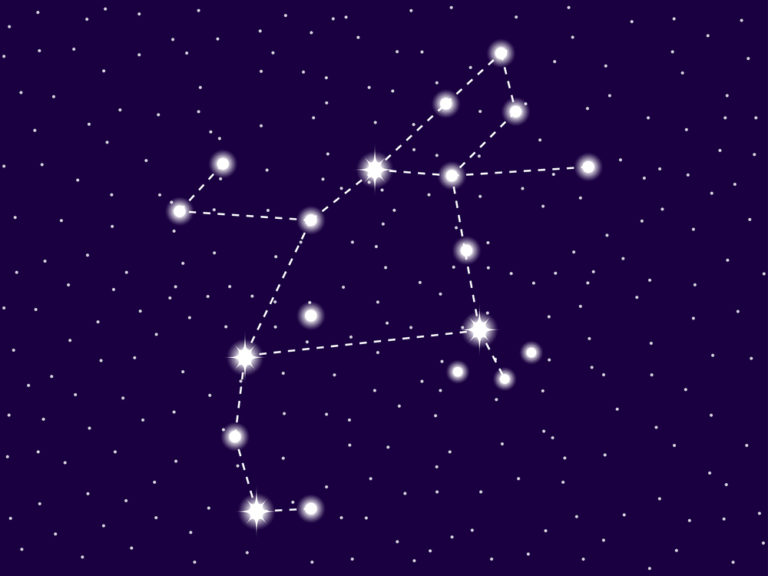Pegasus Constellation: Stars, Myth, and Location (2024)
Object name: Pegasus Constellation
Abbreviation: Peg
Symbolism: The Winged Horse
R.A. position: 21h 12.6m – 00h 14.6m
Dec. position: +2.33° to +36.61°
Distance from earth: The average distance is 199 light-years
Area: 1121 sq. deg.
Brightest star: Enif (ε Peg)
Visible at: Latitudes between +90° and −60°
Best viewed: During the month of October at 9.00pm
The Pegasus constellation is the 7th largest in the sky. It is also known as the Winged Horse. It is an ancient constellation that dates back to Greek times and is associated with a mystical horse who teamed up with a mortal Bellerophon, to accomplish many missions.
Pegasus can be found in the sky by locating Pisces the Fish and Aquarius the Water-Bearer. Pegasus is an exciting constellation to explore, offering the spectacular Stephan’s Quintet of 5 galaxies.
Read on to learn more about the constellations of Pegasus and interesting Pegasus facts.
- Characteristics
- Features
- Location and visibility
- History of observation
- Mythology and meaning
- Future
Characteristics
Pegasus constellation
Pegasus is a large constellation located in the northern celestial hemisphere. It has many bright stars with fascinating names like Markab, Scheat, Algenib, and Enif.
Pegasus comes from the Greek myth of a beautiful flying horse who sprang from his mother’s neck when she was decapitated. A gruesome story, but the Pegasus constellation meaning is one of hope and joy!
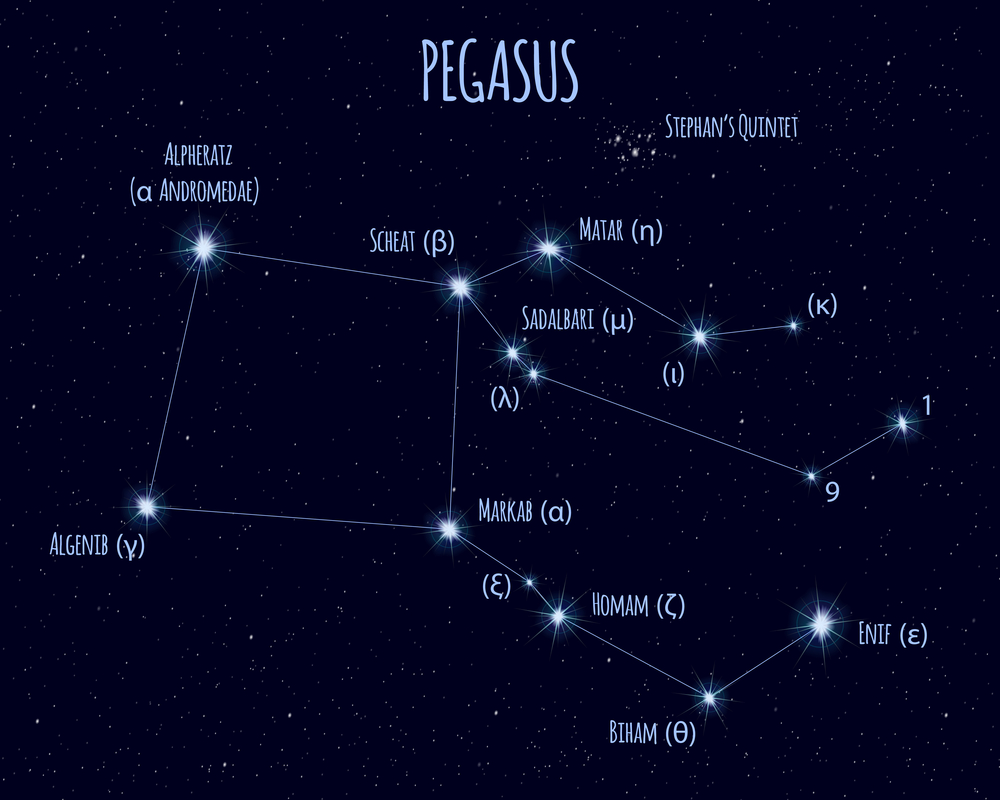
After many adventures, Zeus stabled the horse and placed him into the sky as a constellation. The winged horse belongs to the Pegasus family, also known as the Perseus family. These constellations include Andromeda, Auriga, Cassiopeia, Cepheus, Cetus, Lacerta, Perseus, and Triangulum. They all feature in myths relating to Perseus.
The Pegasus (constellation) occupies an area of 1121 square degrees. The neighboring Zodiac constellations are Pisces the Fish and Aquarius the Water-Bearer. Neighboring constellations that are not part of the Zodiac constellations are Equuleus, Andromeda, Delphinus, and Cygnus.
For home astronomers, Pegasus there are many fascinating Pegasus constellation facts. It contains the amazing NGC 7742, Sunny Side Up, a galaxy that looks like a fried egg. It also has the fascinating 51 Pegasi, a star that is very similar to our Sun, with an orbiting planet. (1).
There is no Pegasus zodiac sign, as Pegasus is not part of the 12 zodiac symbols. The Pegasus sign is a beautiful flying horse. The Pegasus origin and the Pegasus constellation story date back over 3000 years (2).
What does Pegasus constellation look like?
Pegasus is a beautiful mystical white horse with wings. He flies through the skies, wild and free, visiting places of dreams and hopes.
In the sky, the constellation Pegasus is a half horse, pinpointed by major stars. It is up to you to imagine the full body of this magnificent creature.
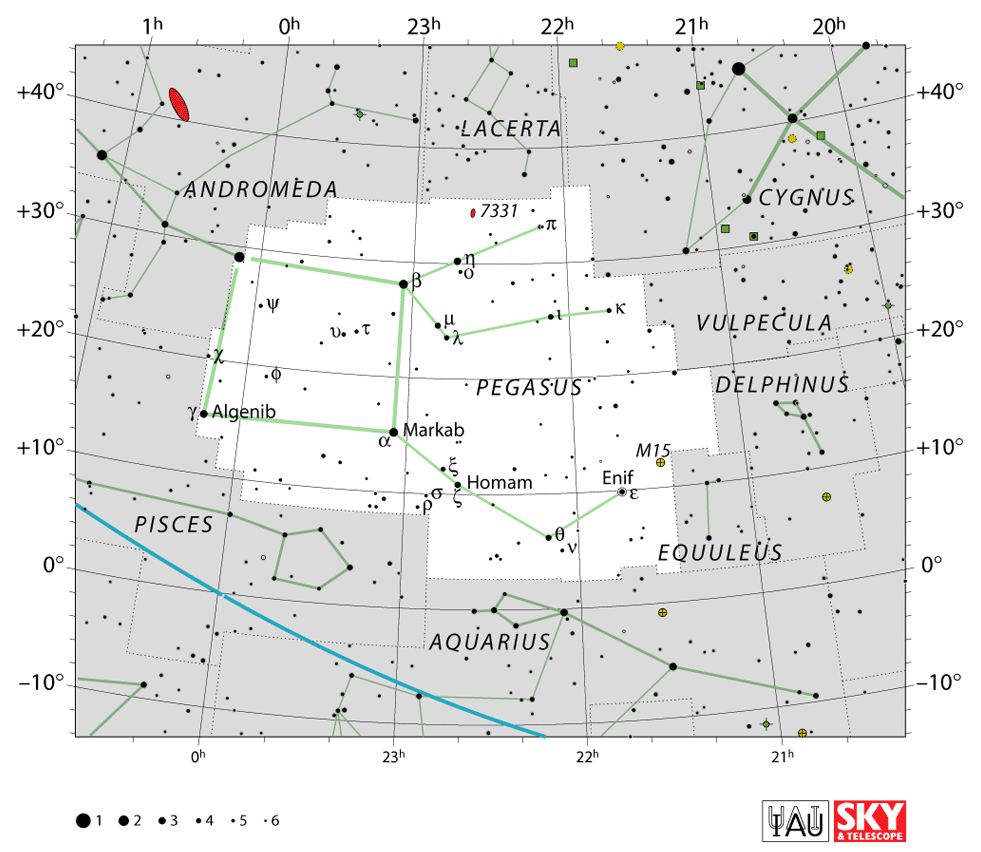
Unlike any other constellation, he flies upside down in the northern hemisphere and right side up in the southern hemisphere. This is a bonus for southern viewers, who always see the constellations upside down.
A prominent pattern of stars, known as an asterism, defines the body of the horse. These stars are the ‘great square of Pegasus’ and mark out his back, belly, hindquarters, and shoulders. His front legs stretch outwards as he gallops at speed across the heavens. His head is held high and you can imagine his mane flowing backward in the wind.
Rising up from his back are two huge wings. They are not pinpointed by stars, but with some creative thinking, you are sure to see them! After all, Pegasus is a mystical creature and brings magic with him.
To complete the image of Pegasus the winged horse, extend his body, add back legs and a large bushy tail. He is always pure white – a stunning apparition in the sky.
How far is Pegasus constellation from earth?
When viewing a constellation from Earth, it appears as if all the stars and celestial bodies are on one flat plane. In reality, this is not correct! They all lie at different distances away, measured in light-years. Some stars may be as close as 40 light-years. Deep-sky objects may be as far as 60 million light-years away.
To give some idea, Markab is 133 light-years away. Skeat is 196 light-years away. Algenib is a blue-white subgiant star that lies about 390 light-years away.
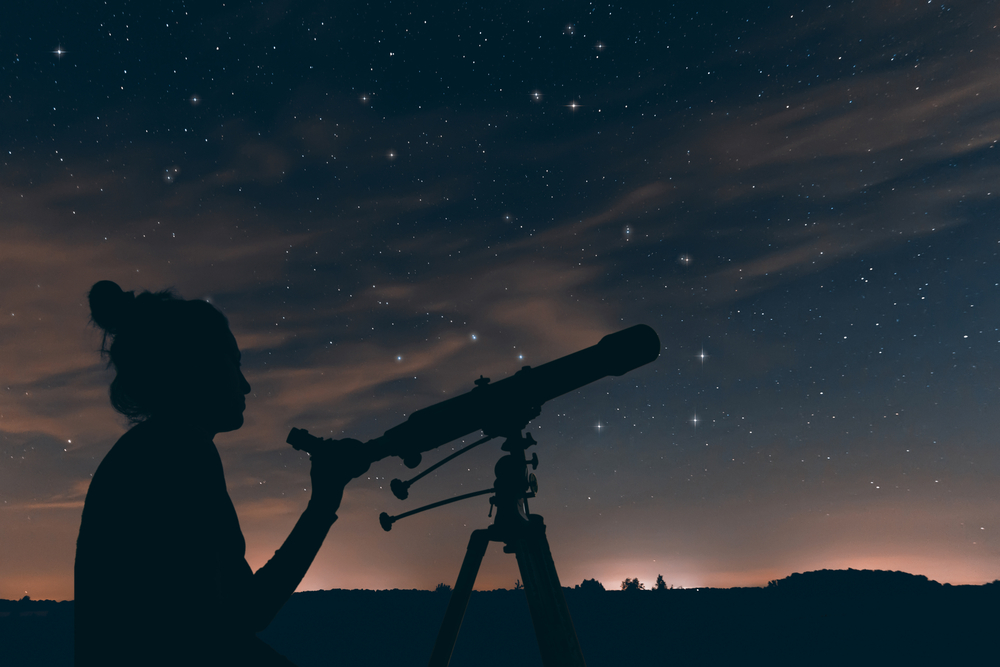
Zeta Pegasi is a blue-white main-sequence star, also known as Homam. It is about 204 light-years away. Matar or Eta Pegasi is another major star Pegasus. It is about 167 light-years away. Sadalbari is 106 light-years away from Earth.
Much further away is Stephan’s Quintet, a cluster of 5 galaxies, about 280 million light-years from Earth. The beautiful NGC 7320 galaxy lies 39 million light-years from our Solar System.
Taking into account the brightest stars and their individual distances, the average distance to the Pegasus constellation from Earth is about 199 light-years. If you consider the deep-sky galaxies, the distance is around millions of light-years.
Features
Major stars in Pegasus
Here is a list of major stars in Pegasus constellation. Home stargazers ask – how many stars are in the Pegasus constellation? There are thousands! Read on to learn all about Pegasus stars.
The Great Square Of Pegasus – Asterism
The Great Square of Pegasus is a well-known asterism or star pattern. It is made up of 4 stars, Markab (Alpha Pegasi), Scheat (Beta Pegasi), Algenib (Gamma Pegasi) and Alpheratz.
Alpheratz is not part of Pegasus but belongs to Andromeda. It is, however, an important Pegasus star as it defines one corner of the square constellation.
The great square marks out the body of the horse and you can see it without using a telescope. What is the brightest star in the Pegasus constellation? Alpheratz would be the brightest star, but it does not officially belong to Pegasus.
Markab – α Pegasi (Alpha Pegasi)
Markab, also known as Alpha Pegasi, is a blue giant with twice the surface temperature of the Sun. It has an apparent magnitude of 2.48 and is approximately 133 light-years away from Earth.
Markab is the 3rd brightest star in Pegasus. It has a radius of five times that of the Sun. The name comes from the Arabic word markab, which means “the saddle of the horse” (4).
Scheat – β Pegasi (Beta Pegasi)
Scheat, also known as Beta Pegasi, is the second brightest star in the constellation of Pegasus. It is also the second brightest star in the Great Square asterism, with an apparent magnitude of 2.42.
You can see Scheat without using a telescope. It is a red giant star in the upper right corner of the asterism. It lies 196 light-years away.
This star is losing mass quite fast and is covered by a growing cloud of gas and dust. Scheat has a radius of about 46 times bigger than the Sun, but its surface temperature is lower, at only 3,689 K. The name Scheat, comes from the Arabic Al Sā’id, which means “the upper arm” (5).
Algenib – γ Pegasi (Gamma Pegasi)
Algenib is a blue-white subgiant star with an apparent magnitude of 2.84. It is the 4th brightest star after Enif, Scheat, and Markab. The star lies about 390 light-years away.
The star marks the lower left-hand corner of the Great Square of Pegasus. Algenib is about nine times as massive as the Sun and has about five times the radius of the Sun, and is 5840 times more luminous. The name comes from the Arabic al-janb, which means “the side”.
Enif – ε Pegasi (Epsilon Pegasi)
If you exclude Alpheratz, Epsilon Pegasi is the brightest star in Pegasus. It has an apparent visual magnitude of 2.3 and lies about 690 light-years away from the Sun. Enif is an orange sequence supergiant, that has a radius of 185 times that of the sun.
It is 5000 times more luminous. The name comes from the Arabic word for “the nose” and marks the muzzle of the horse. You can see Enif in the Pegasus star constellation without the need for a telescope (6).
Homam – ζ Pegasi (Zeta Pegasi)
Zeta Pegasi is a blue-white main-sequence star with an apparent magnitude of 3.414. It lies about 204 light-years away from the Sun. Homam is a double star that astronomers can resolve with a powerful telescope.
Home stargazers can see it as a single star with the naked eye. Homam has a radius of times that of the Sun. It is a rapidly rotating star, with a velocity of between 140 and 210km/s. The name comes from Arabic and means “the lucky star of the high-minded” or “man of high spirit” (7).
Matar – η Pegasi (Eta Pegasi)
Eta Pegasi is another major star Pegasus. The name comes from the Arabic phrase Al Saʽd al Maṭar, which means “the lucky star of rain”. It lies about 167 light-years away.
With an apparent visual magnitude of 2.95, it is the fifth brightest star in the constellation.
Matar has two stars that orbit each other within a period of 813 days. The name Matar comes from the Arabic phrase Al Saʽd al Maṭar, which means “the lucky star of rain.” Matar pinpoints the knee of the left front leg of the horse.
Sadalbari
Sadalbari, also known as Mu Pegasi is a yellow giant star that lies at the top of the right leg of the horse. With an apparent visual magnitude of 3.514, you can see it without using a telescope.
The star lies about 106 light-years away from Earth. It has a radius of about 10 times that of the Sun, but its mass is only 2.7 times that of the Sun. The name comes from the Arabic phrase for “luck star of the splendid one”.
IK Pegasi
IK Pegasi is a double star about 150 light-years away. It has a faint apparent visual magnitude of 6.078 and you need a telescope to view it. The two stars orbit one another in a period of 21.7 days.
IK Pegasi B is a white dwarf and is the nearest supernova candidate known, which will eventually explode as a Type Ia supernova. A Type Ia supernova is caused by the transfer of matter onto a white dwarf by its close companion star, causing it to eventually collapse (8).
Deep-sky objects in Pegasus
Cumulo de Pegaso – Messier 15 (M15, NGC 7078)
Messier 15 is the oldest known globular Pegasus cluster with an age of around 12 billion years. It is also known as the Great Pegasus Cluster, the Cumulo de Pegaso. Italian-born astronomer Jean-Dominique Maraldi discovered it in 1746 and added it to Charles Messier’s catalog in 1764.
The cluster contains more than 100,000 stars, including many variables and pulsars, and the double neutron star M15 C. M15 lies about 33,600 light-years away and has an apparent magnitude of 6.2 (9).
Stephan’s Quintet (HCG 92, Arp 319)
Stephan’s Quintet is a group of five galaxies, NGC 7317-7320, that lie about 280 million light-years from Earth. The French astronomer Édouard Stephan, discovered them while at the Marseilles Observatory in 1877.
This galaxy Pegasus is an amazing sight for home stargazers. Three of the galaxies have unusual shapes. You will see long, gaseous tails of star clusters and elongated spiral arms.
Because they are close together, the interactions have sparked off new star births in the central pair of galaxies. The brightest red galaxy Pegasus in the group is NGC 7320, which is a mere 40 million light-years away (10).
NGC 7320
NCG 7320 is part of Stephan’s Quintet. It is a classic spiral galaxy and lies about 39 million light-years from our Solar System. It has a visual magnitude of 13.2, which is faint and you need a fairly powerful telescope to view it.
NGC 7320 shows extensive star-forming regions, visible as red blobs. The bright blue dots are young star clusters. In this galaxy, The Hubble telescope can resolve individual stars, showing that NGC 7320 is closer to Earth than the other members of Stephan’s Quintet (11).
NGC 7317
Above, a 12 arcmin wide SDSS image centered on Stephan’s Quintet, also showing PGC 69279 (Image Credit NASA, ESA, and the Hubble SM4 ERO Team)
NGC 7317 is another galaxy in Stephan’s Quintet. It is an elliptical galaxy with an apparent magnitude of 14.57, which is faint and you cannot see it with the naked eye. Elliptical galaxies are one of three main classes defined by Edwin Hubble in 1936.
They have almost no discernible structure and appear as massive blobs. With a home telescope, you will see a faint fuzzy patch of light in the dark sky. The distance to Pegasus galaxy is about 300 million light-years away (12).
NGC 7318
NGC 7318 is a pair of galaxies that are in a state of collision. The two components are NGC 7318 a and NGC 7318 b. They lie about 300 million light-years away from our Solar System.
NGC 7318a has an apparent magnitude of 14.4. NGC 713b has an apparent magnitude of 13.9. This is very faint and you will not see it with the naked eye. The galaxy is part of Stephan’s Quintet.
NGC 7319
NGC 7319 is a spiral galaxy, also part of Stephan’s Quintet. These galaxies have formed by massive galactic collisions over millions of years. The NGC 7319 Pegasus nebula lies about 360 million light-years away from our Solar System.
It has an apparent magnitude of 14.1, which is faint and requires a powerful telescope to view. According to astronomers, the clusters in NGC 7319’s streaming tail are 10 million to 500 million years old and may have formed at the time of the crash (13).
NGC 7742 – Sunny Side Up
NGC 7742 is an unbarred spiral galaxy. Unbarred galaxies do not have a clear central bar of stars. This galaxy has a ring instead that gives fabulous images when viewed through a powerful telescope.
NGC 7742 has a visual magnitude of 12.35 and is approximately 72.4 million light-years away from the Sun. Its Pegasus constellation nickname is “Sunny Side Up” as it looks like a fried egg! In the photo, the ring around the galaxy is about 3,000 light-years from the core (14).
NGC 7331 (Caldwell 30)
NGC 7331 is a spiral galaxy with a visual magnitude of 10.4. it lies about 45 million light-years away from our Solar System. This is an exciting galaxy in that it has a structure very similar to our Milky Way.
British astronomer William Herschel discovered it in 1784. Caldwell 30 lies at the northern boundary of the constellation Pegasus and is only about half a degree away from Stephan’s Quintet. Although they appear to be near one another when viewed through a telescope, the Quintet is in reality six times farther away from Earth.
Exoplanets in Pegasus
Exoplanets are planets that revolve around stars, other than our star, the Sun. Exoplanets excite astronomers as they may offer conditions similar to those in our Solar System, with the possibility of life.
51 Pegasi
51 Pegasi is a main-sequence star about 50.9 light-years away from Earth. It has an apparent magnitude of 5.49. 51 Pegasi was the first star ever discovered similar to our Sun that has a planet in its orbit.
The exoplanet is 51 Pegasi b and was discovered recently in October 1995. It has a mass of half a Jupiter. The planet has the nickname Bellerophon, from the myth of Pegasus. 51 Pegasi b has a mass of 0.46 Jupiters. It takes 4.2 days to complete one orbit of its star (15).
HD 219828
HD 219828 is a yellow subgiant star with 2 known exoplanets. They lie 295 light-years away. HD 219828 b is a Neptune-like exoplanet that takes 3.8 days to complete one orbit of its star.
It has a mass of 20.9 Earths. Its discovery was in 2007. HD 219828 c has a mass of 14.6 Jupiters and takes 12.8 years to complete one orbit of its star. Its discovery was in 2016.
HD 214823
HD 214823 is a yellow star, 218 light-years away with an apparent magnitude of 3.81. The star has one exoplanet HD 214823 b. HD 214823 b has a mass of 20.3 Jupiters. It takes 5.1 years to complete one orbit of its star. Its discovery was in 2016 (16).
HR 8799
HR 8799 is a blue-white main-sequence star that lies about 128 light-years away. It has 4 known exoplanets, named HR 8799 b, c, d, and e. HR 8799 b is a gas giant exoplanet with a mass of 7 Jupiters.
It takes 465.8 years to complete one orbit of its star. Its discovery was in 2008. HR 8799 c is a gas giant exoplanet with a mass of 0 Jupiters. It takes 189 years to complete one orbit of its star. Its discovery was in 2008.
Meteor showers in Pegasus
Meteor showers occur when Earth crosses the orbital path of a comet. Dust and debris from the remnants of the comet enter the Earth’s atmosphere and burn up. This creates a spectacular show, often known as shooting stars.
July Pegasids
The meteor shower occurs between 7 July and 13 July, with the peak on 9 July. July Pegasids is a weak shower and you can expect to see around 3 meteors per hour. Although they are not abundant, they do travel at high speeds of up to 70km/s.
The radiant of the shower is the point from where it originates. The July Pegasids originate near the star α Pegasi, also known as Markab. Markab lies on the back of the horse, where the saddle sits. It is a bright star that you can see with the naked eye.
The origin of this meteor shower is the comet C/1979 Y1, discovered by The New Zealand astronomer, William Ashley Bradfield. The comet has an orbital period of 300 years (18).
The Epsilon Pegasids (EPG)
Dr. Peter Brown, using data from the Canadian Meteor Orbit Radar installation, discovered this weak shower. It occurs between 3 July and 23 July with the peak on 11 July.
The radiant star is Enif, the brightest star in Pegasus constellation. Hourly rates are less than 1 – this is not a very exciting shower. The meteors travel slowly at speeds of 28km/s, so if you do see one, it won’t vanish in a second and you may even be able to snap a photo (19).
Location and visibility
Where is Pegasus constellation located?
Pegasus is a large constellation with many bright stars and you can easily spot it once you know what to look for. In dark skies, you can see the main stars without a telescope. Then, you can imagine the mystical white horse flying through the heavens on his next mission.
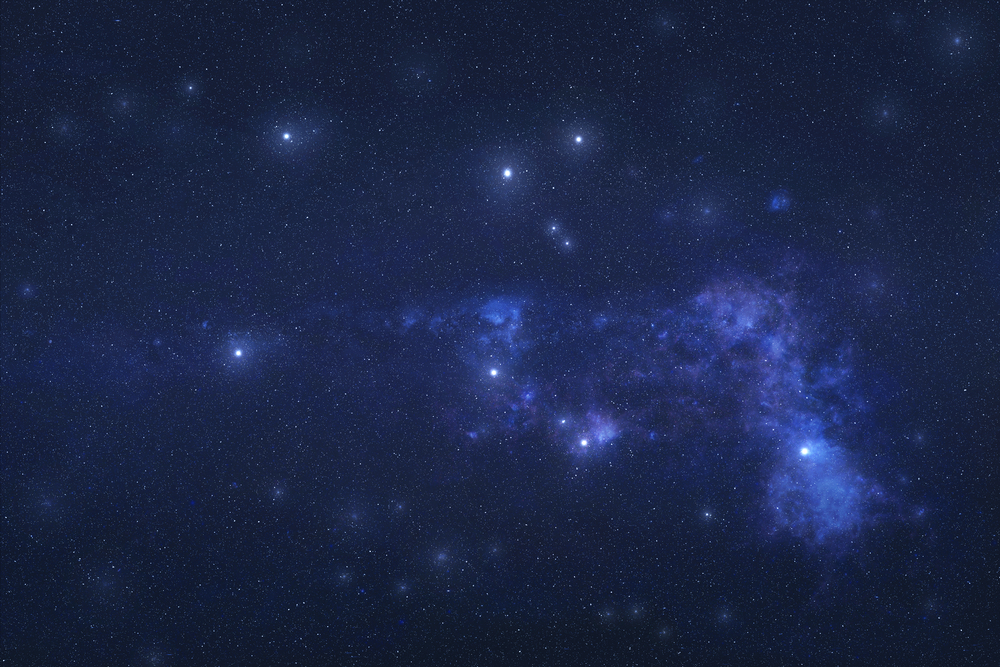
Where is Pegasus in the sky?
Pegasus is a southern constellation and the 7th largest constellation of the 88 named constellations. It occupies an area of 1121 square degrees. Pegasus lies in the fourth quadrant of the northern hemisphere, NQ4.
A quadrant is essentially a quarter of a circle, which allows astronomers to measure the altitude of objects above the horizon. You can see the constellation at latitudes between +90° and −60°.
To find the Pegasus constellation location, you can find the two zodiac constellations of Pisces the Fish and Aquarius the Water Bearer. The Fish are on the south side, under the horses’ back. Aquarius lies underneath the head of the horse.
Also close to Pegasus is Equuleus, the ‘little horse’. Because Equuleus rises before Pegasus, this constellation is often known as Equus Primus, or the First Horse (20).
When is Pegasus constellation visible?
When is Pegasus visible? Pegasus is visible in both the northern and southern hemispheres.
If you are in the northern hemisphere – In July and August Pegasus will first appear low on the eastern horizon between 10pm and midnight. By around 4am the constellation will be directly overhead.

From September to October the constellations Pegasus is visible much earlier, at around 8pm in the eastern sky. It will move directly overhead towards midnight. In November to January, you can see the square constellation high in the eastern sky from 6pm. The perfect to plan an evening of stargazing with the children.
In the southern hemisphere – In August, Pegasus in space is visible at around 11pm, low on the north-eastern horizon. By 3am it will be high in the northern sky.
From September to October, it becomes visible in the north-eastern sky at around 8pm, gradually moving northwards. In November and December, Pegasus the horse appears in the northwest at around 10pm before disappearing below the horizon a few hours later.
Remember – in the southern hemisphere, all constellations appear upside down. In this case, the Pegasus star constellation is the right way up!
How to find Pegasus constellation?
Northern Hemisphere
Here’s a step-by-step guide on how to find Pegasus constellation.
- To find the Pegasus location, it is easiest to first find the Big Dipper in Ursa Major, the Great Bear
- Then star-hop downwards to Polaris, the bright North Star
- Draw an imaginary line from any Big Dipper handle star through Polaris, double the distance and you will land on the W-shaped constellation Cassiopeia
- Continue your line to the bright star, Alpheratz at the top corner of the Great Square of Pegasus
- Locate the other 3 bright stars of the great square and you have the body of the horse
- You can also find Pisces the Fish and locate the Great Square of Pegasus, nestling inside the two ropes that bind the fish together
- The constilation Pegasus is upside down in the northern hemisphere
Southern Hemisphere
In the Southern Hemisphere, Pegasus constellation stars are one of the few images that appear the right way up! So where is Pegasus and what shape marks the Pegasus constellation?
- To find the Pegasus location, it is easiest to first find the Big Dipper in Ursa Major, the Great Bear
- Then star-hop upwards to Polaris, the bright North Star
- Draw an imaginary line from any Big Dipper handle star through Polaris, double the distance and you will land on the M-shaped constellation Cassiopeia
- Continue your line to the bright star, Alpheratz at the lower corner of the Great Square of Pegasus
- Locate the other 3 bright stars of the square and you have the body of the horse
- You can also find Pisces the Fish and locate the constellation horse nestling inside the two ropes that bind the fish together (21).
How to view Pegasus Constellation?
Pegasus the winged horse constellation as imagined in the southern hemisphere
Pegasus is the 7th largest constellation in the sky. It has a well-defined star pattern or asterism, known as the Great Square of Pegasus. By locating these stars, you can imagine the winged horse constellation in the sky.
Like all stargazing experiences, getting away from city lights is the best way to see constellations and deep-sky objects. You can see the horse constellation with the naked eye, but using a telescope will make it so much more exciting.
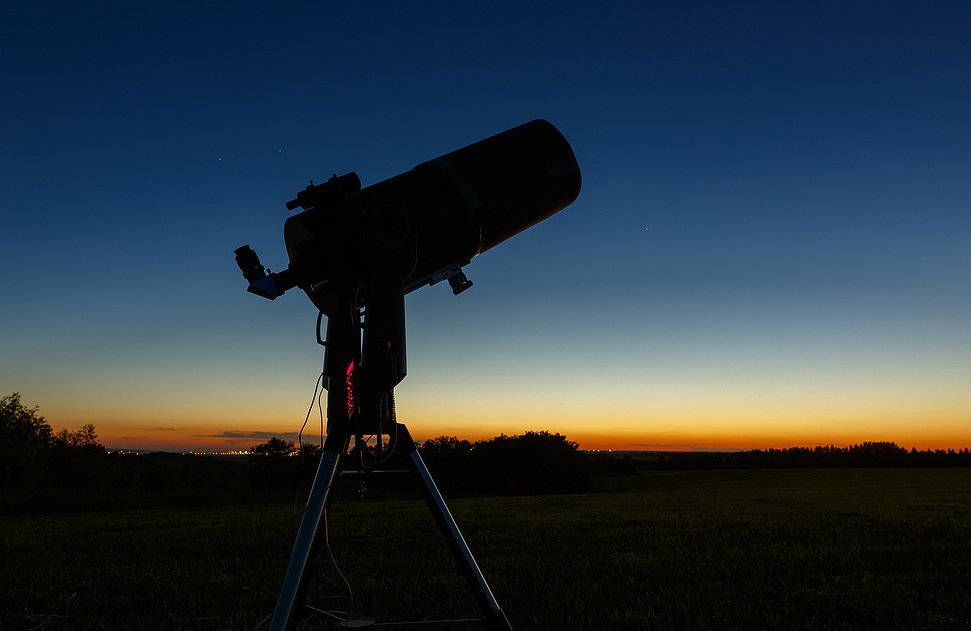
For amateurs, there is a great choice of well-priced scopes that will give you fabulous images of Pegasus rising in the sky.
Depending on your budget, plan to spend from $250 to $900 on a telescope that will give a lifetime of viewing.
The Orion StarBlast 6i Intelliscope Reflector Telescope is a great choice for a family wanting to stargaze. It is extremely portable and comes with a table mount that is easy to set up and operate.
The scope has a 6″ aperture and a 750mm focal length which gives clear, crisp images of the Pegasus constellation. It comes with an Orion IntelliScope computerized object location system that allows you to find any stars in Pegasus by using the easy-to-use handheld locator.
The Orion 6i Intelliscope Reflector Telescope comes with 2 eyepieces, a 25mm and a 10mm Sirius Plossl 1.25″. It also offers an eyepiece rack, EZ Finder II aiming device, and Starry Night Software. This is a very well-priced scope with exceptional features.
History of observation
Who discovered Pegasus constellation?
Pegasus history dates back to ancient civilizations of the Greeks, Chinese and Hindus, and was documented in stories, folklore, and myths.
Obverse silver tetradachm from Corinth, showing Pegasus flying.
The greek Pegasus dates as far back as 3000BC. It associates with the flying horse who sprung from his mother’s neck when she was beheaded. In Pegasus history, the horse was tamed by Bellerophon, a mortal, and together they had many adventures.
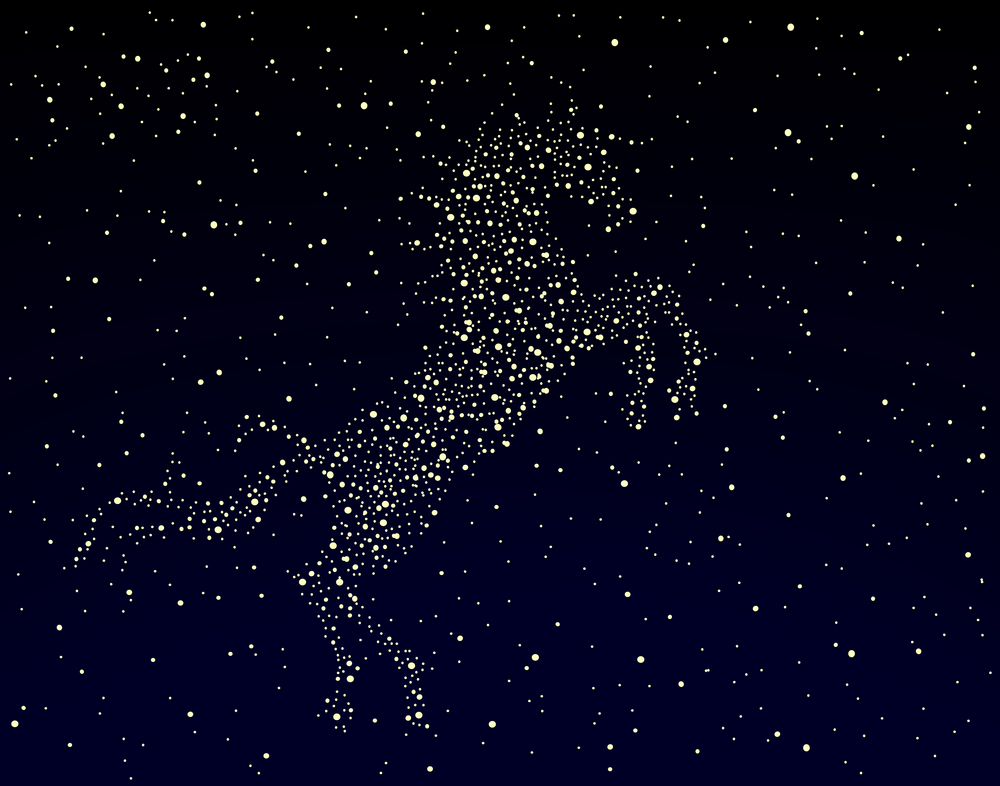
Here are some more fascinating Pegasus facts in greek mythology – Ancient coins from Corinth show images of the horse Pegasus. The winged horse image is also painted onto many ancient Greek jars dating back to 400BCE (22).
The Pegasus stars also feature in Chinese astronomy dating back to 750BC. The horse lies in the area of the sky known as the Black Tortoise of the North. The name of the western constellation in modern Chinese is fēi mǎ zuò which means “the flying horse constellation”.
In Hindu astronomy, written during the 5th and 6th century, Pegasus constellation history associates with Purva Bhadrapada, sharing two of its stars, Markab and Scheat. Markab denotes honor and success and Scheat gives literary and poetic ability, with extreme sorrows (23).
In more recent times, the famous astronomer Ptolemy officially named the Pegasus constellation. He lived between 90 AD and 168 AD.
How old is Pegasus constellation?
Pegasus is an ancient constellation, and Pegasus history dates back to the era of Greek mythology around 3000BC. The constellation depicts the myth of the winged horse, who sprang from Medusa’s neck after she was beheaded.
He achieved many successful missions with a mortal named Bellerophon. After Zeus took the horse and stabled him, Pegasus in Greek mythology was awarded for long dedicated service and placed into the sky by the King of the Gods (24).

Pegasus is also an old Chinese constellation known as far back as 750BC. It lies within the northern quadrant of the sky, symbolized as the Black Tortoise of the North.
Around the 5th and 6th centuries, Hindu astronomers wrote about the Pegasus legend. He associates with Purva Bhadrapada, sharing two of its main stars, Markab and Scheat (25).
Also known to the Persians, the famous astronomer al-Sufi imagined a complete horse rising out of the ocean. He documented his findings during his life, 903AD to 986AD. The story became part of Persian Pegasus astrology (26).
In biblical times, Revelations, written by John the Elder, around 96AD, referred to a white horse – “Then I saw heaven open and there were a white horse …” Revelations 19:11 (27).
How did the Pegasus constellation get its name?
Most constellations get their names from ancient cultures, folklore, or mythology. So, what is the Pegasus name meaning?
The word Pegasus relates to the Greek word pegai, or pege, meaning a spring. In the origin of Pegasus, the horse had magical powers and wherever his hoof landed, a water spring would gush forth, bringing life and poetic inspiration.
The Greek word pegazo, means to ‘spring forth’ or ‘to gush forth’. A natural spring in Greece called Hippocrene, or the ‘horse spring’ takes its name from Pegasus.
In English, it relates to ‘peg’, an instrument used to measure the level of waters in underground springs (28). The English peg comes from the German word pegel, a gauge rod, or a watermark.
In the Bible, what does Pegasus mean? There is a reference to a white horse – “Then I saw heaven open and there was a white horse. Its rider is called Faithful and True…. His eyes were like a flame of fire, and he wore many crowns on his head…. The armies of heaven followed him riding on white horses…” Revelations 19:11 (29).
Here are some more facts about Pegasus. The word Pag or Pega, to the Phoenicians, was the figurehead on their ships, a creature called the Bridled Horse. The Pegasus nickname or abbreviation is Peg.
Mythology and meaning
Pegasus myth
The Winged Horse is a creature from Pegasus Greek mythology. He has a fascinating story! Pegasus and his brother, the golden-sworded Chrysaor, sprang from their mother’s neck after she was beheaded. This strange story starts with Medusa, the mother.
She was a beautiful woman who was turned into a terrible gorgon monster by the goddess Athena after being caught being defiled by the Sea God Poseidon. Athena turned Medusa’s hair into snakes and made her face so ugly that anyone who looked into her eyes was horror-struck and immediately turned to stone.

In the mythology Pegasus, Perseus was a demi-god, the son of Zeus, and a mortal named Danae. When Perseus was young, Polydectes took him and his mother under his care and raised Perseus as his own son. Polydectes sent Perseus to kill Medusa and save Andromeda from the sea monster Cetus.
Perseus succeeded in his mission by beheading the Gorgon monster. As her head rolled off, Pegasus and Chrysaor sprang from her neck.
In Pegasus mythology, Pegasus’ father was Poseidon God of the Sea, and Pegasus was capable of creating water streams wherever he struck his hoof. A famous spring in Greece, named Hippocrene, the Horse Spring, is thought to have been created by Pegasus’ hoof.
In the Pegasus story, the winged horse roamed wild and free, until his capture by a mortal called Bellerophon, a celebrated hero and slayer of monsters. As a pair, Bellerophon, riding Pegasus, overcame the Amazons, the fire-breathing Chimaera, and the warlike Solymi.
After time, Bellerophon started believing that the mortals aren’t worthy of his presence and would rather live among the gods on Mount Olympus. Zeus was angered by Bellerophon’s attitude and sent a gadfly to sting Pegasus.
In his fright, the winged horse threw his rider down to earth and to his death. Zeus stabled Pegasus with his other steeds and after many years of service, placed him into the sky. To this day, the stars depict the Pegasus constellation myth (30).
What does Pegasus symbolize?
From the above picture, it is easy to see what does Pegasus represent. Pegasus is a creature of breathtaking beauty. He is wild and free, able to cross the boundaries of time and space.
Pegasus shows us that no boundary can stop us if we desire it enough. He is immortal, but spent many years of his life on Earth with a human rider named Bellerophon. Together, they achieved great missions. Pegasus can soar across oceans, over mountains, and reach faraway planets unknown to Man.
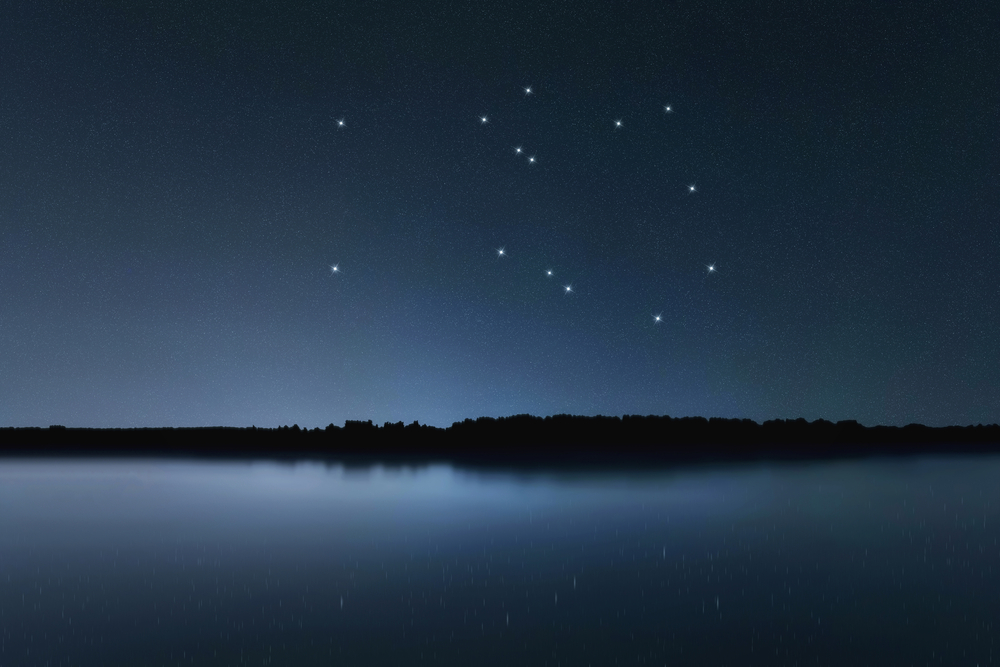
He is a dreamer and an achiever. As he did with Bellerophon, Pegasus comes to us in times of need and takes us into the realm of our dreams. Pegasus symbolism is joyful, hopeful, a bringer of positiveness, lifting away sadness and sorrow.
Pegasus means living life to the full and striving for anything you want. With the Winged Horse in your heart, you will embrace new experiences and achieve happiness and freedom.
As a spiritual symbol, the Pegasus symbol represents life. In the myth, the horse created a fountain of water wherever he struck his hoof. This represents the fountains of youth. Pegasus symbols represent true beauty in the purest form (31).
Future of Pegasus constellation
Pegasus is a constellation that is fascinating for astronomers to study.
It contains the IK Pegasi double star that lies about 150 light-years away. It has a faint apparent visual magnitude of 6.078 and you need a telescope to view it. The two stars orbit one another in a period of 21.7 days.
IK Pegasi B is a white dwarf and is the nearest supernova candidate known. It will eventually explode as a Type Ia supernova. A Type Ia supernova is caused by the transfer of matter by the larger star onto a white dwarf causing it to collapse and explode. When this happens, it will be a spectacular sight to see. Although it may still take a few million years. (32).
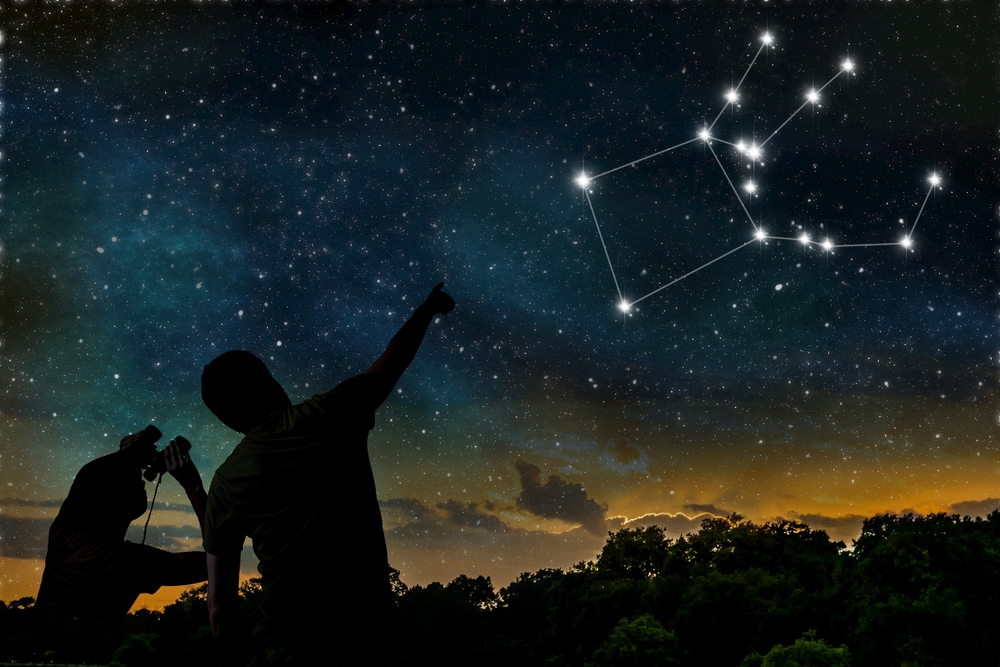
Also evolving in Pegasus, is NCG 7320, a spiral galaxy in Stephan’s Quintet. NGC 7320 shows extensive star-forming regions, visible as red blobs in a telescope image. You will also see bright blue dots which are young star clusters. Forming stars are of great interest to astronomers as they unlock the mysteries of the Universe.
NGC 7319 is a spiral galaxy, also part of Stephan’s Quintet. Scientists have seen an ‘interloper’ in the middle of the galaxy. It is a quasar and first seen in January 2005. The light spectrum indicates that it is billions of light-years distant, much further away than the galaxy itself.
Astronomers are asking – how can a galaxy so close to the earth, contain a celestial object so far away? Future studies may reveal that we still do not know enough about the mysteries of the Universe (33).

